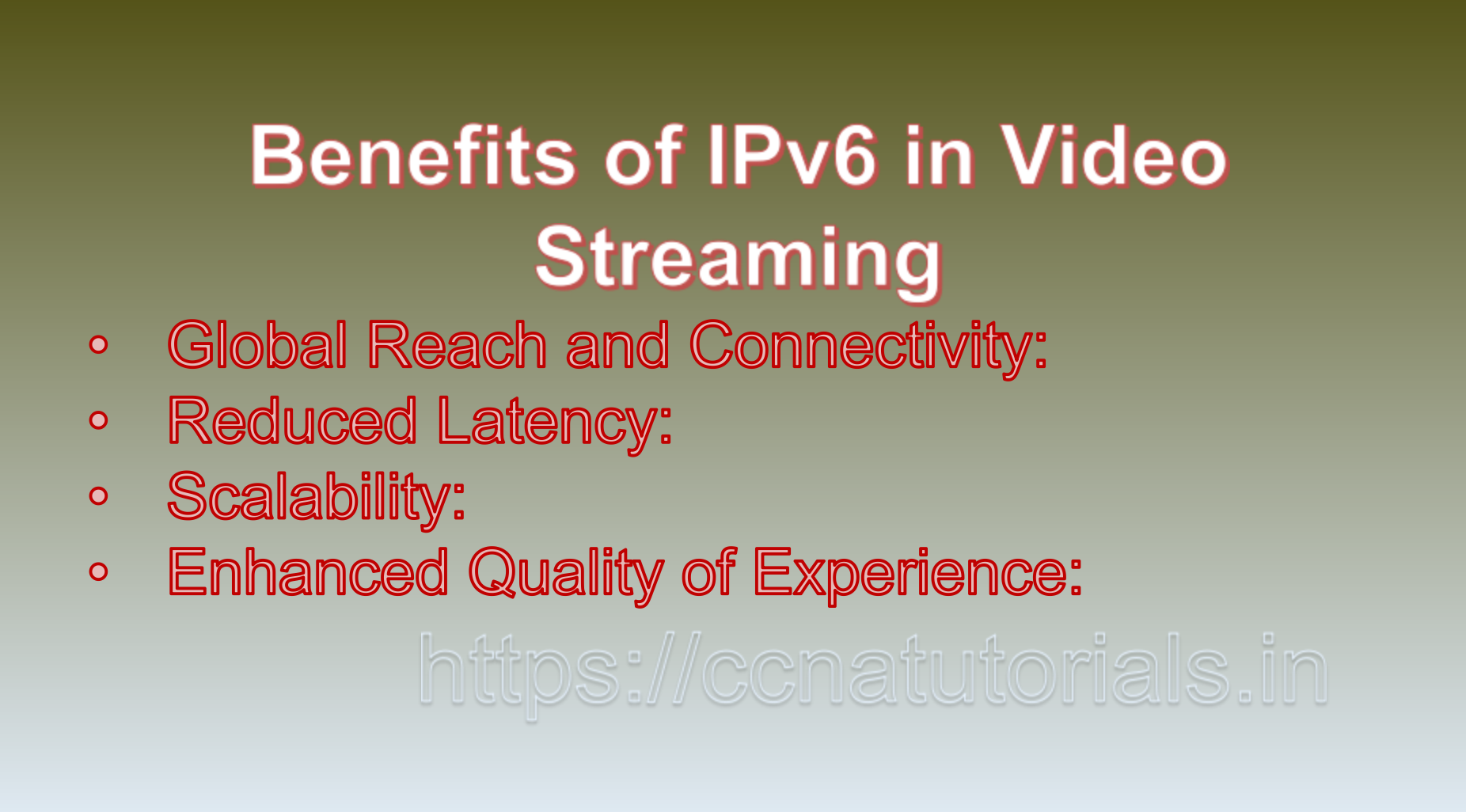Contents of this article
IPv6 and Video Streaming: Enabling Seamless Content Delivery in the Digital Era. In the modern digital landscape, video streaming has become an integral part of our online experience, revolutionizing how we consume and share multimedia content. Internet Protocol version 6 (IPv6) plays a significant role in enhancing video streaming by addressing the limitations of its predecessor, IPv4, and providing an expansive address space that supports the growing demand for online video content. In this article, we will explore the relationship between IPv6 and video streaming, their benefits, implementation considerations, and provide examples to illustrate their importance in delivering high-quality video content to global audiences.
Understanding IPv6 and Video Streaming
IPv6: IPv6 is the sixth version of the Internet Protocol, designed to overcome the limitations of IPv4 and provide a larger address space to accommodate the ever-increasing number of connected devices in the digital world. IPv6’s 128-bit address format allows for trillions of unique IP addresses, ensuring the availability of addresses for all devices, including those involved in video streaming.
Video Streaming: Video streaming is the process of delivering multimedia content, such as videos, in real-time over the internet. It allows users to watch videos without the need to download them fully, enabling seamless playback while the content is being transmitted.
Benefits of IPv6 in Video Streaming
1. Global Reach and Connectivity:
IPv6’s vast address space ensures that video streaming platforms can cater to global audiences without facing address shortage issues. This allows users from different regions to access content simultaneously.
2. Reduced Latency:
IPv6’s optimized routing and addressing contribute to reduced network congestion and lower latency, resulting in smoother video playback with minimal buffering.
3. Scalability:
The expansive address space of IPv6 supports the scalability of video streaming services, allowing platforms to accommodate a large number of concurrent users and high-demand events.
4. Enhanced Quality of Experience:
IPv6’s efficient routing and end-to-end connectivity contribute to better video quality, fewer interruptions, and a seamless viewing experience for users.
IPv6 Implementation Considerations in Video Streaming
1. Infrastructure Readiness:
Content delivery networks (CDNs), streaming servers, and related infrastructure must be IPv6-ready to ensure that video content is accessible to IPv6-enabled devices.
2. Dual-Stack Support:
Many networks employ a dual-stack configuration that supports both IPv4 and IPv6. Video streaming platforms need to ensure compatibility with both protocols.
3. Testing and Optimization:
Ensuring smooth video playback requires testing and optimization for IPv6-specific challenges, such as path MTU discovery and NAT traversal.
Examples Illustrating IPv6 and Video Streaming
1. Global Video Platform:
Consider a popular video streaming platform that uses IPv6 to deliver content to its users. By leveraging IPv6’s benefits, the platform can:
– Offer consistent, high-quality video streaming to users worldwide without facing address scarcity.
– Provide seamless streaming experiences during high-demand events, such as live sports broadcasts.
– Enhance the viewer experience by minimizing buffering and reducing latency, leading to smoother playback.
2. OTT Services:
Over-the-top (OTT) streaming services deliver video content over the internet, bypassing traditional cable or satellite TV providers. With IPv6, OTT services can:
– Reach a broader audience by leveraging IPv6’s expansive address space, accommodating users from diverse geographical locations.
– Ensure that viewers accessing content through IPv6-enabled devices experience consistent quality without disruptions.
Short description of IPv6 and Video Streaming
IPv6’s integration with video streaming has revolutionized the way we consume multimedia content online. Its expansive address space, reduced latency, and enhanced scalability contribute to a seamless video streaming experience for users around the world. As video streaming continues to dominate internet traffic and the demand for high-quality content grows, the synergy between IPv6 and video streaming becomes increasingly crucial in delivering consistent, buffer-free, and enjoyable video experiences to a global audience. By embracing IPv6, video streaming platforms and content providers can cater to the evolving needs of users in the digital era.

IPv6 and Video Streaming: Enabling High-Quality Content Delivery in the Digital Era
IPv6 (Internet Protocol version 6) and video streaming have become integral components of modern digital experiences. The integration of IPv6 with video streaming technologies revolutionizes the way we consume and deliver video content over the internet. This combination offers benefits such as improved performance, enhanced user experience, and efficient content delivery. In this article, we will explore the relationship between IPv6 and video streaming, the advantages they bring, and provide examples to illustrate their significance in the world of digital entertainment.
Understanding IPv6 and Video Streaming
IPv6: IPv6 is the next generation of the Internet Protocol, designed to replace the aging IPv4. It addresses the limitations of IPv4 by providing a significantly larger address space, ensuring that the growing number of connected devices can be uniquely identified and accessed on the internet.
Video Streaming: Video streaming refers to the process of delivering video content in real-time over the internet. It allows users to watch videos without downloading the entire file, resulting in faster access to content and a seamless viewing experience.
Benefits of IPv6 and Video Streaming Integration
1. Improved Content Delivery:
IPv6’s enhanced routing and addressing capabilities contribute to efficient content delivery, reducing latency and ensuring smoother video streaming.
2. Enhanced User Experience:
IPv6’s optimized network pathways lead to faster loading times and uninterrupted streaming, enhancing the overall viewing experience.
3. Scalability:
IPv6’s abundant address space supports the scalability demands of video streaming platforms that serve a global audience and host large libraries of content.
4. Mobile-Friendly:
IPv6 is well-suited for mobile devices, making it easier for users to access video content on smartphones and tablets.
5. Multimedia Services:
IPv6’s capacity for multimedia services facilitates the delivery of high-definition (HD) and ultra-high-definition (UHD) video content, catering to the increasing demand for high-quality visuals.
IPv6 and Video Streaming Implementation Considerations
1. Content Distribution Networks (CDNs):
CDNs play a crucial role in delivering video content efficiently. IPv6-enabled CDNs ensure that content is distributed seamlessly to users with IPv6 connections.
2. Network Infrastructure:
Service providers and platforms need to ensure their network infrastructure supports IPv6 to offer uninterrupted video streaming to users with IPv6-enabled devices.
3. Device Compatibility:
Video streaming applications and devices must support IPv6 to take advantage of its benefits. Many modern devices are already IPv6-compatible.
Examples Illustrating IPv6 and Video Streaming Integration
1. Online Video Platforms:
Consider a popular online video streaming platform that delivers a vast library of movies and TV shows to a global audience. By integrating IPv6:
– Users with IPv6-enabled devices experience faster loading times and smoother playback, enhancing their viewing experience.
– The platform can scale its infrastructure to handle increased demand, ensuring that users across the world can access content without disruptions.
– HD and UHD content can be efficiently delivered to devices with IPv6 connections, catering to users’ expectations for high-quality visuals.
2. Live Streaming Events:
During a live streaming event, such as a sports match or a music concert, millions of viewers tune in simultaneously. By leveraging IPv6:
– The live stream is distributed more efficiently to users, reducing the risk of buffering or lag.
– Users on mobile devices with IPv6 connections can seamlessly access the live stream, ensuring a smooth experience regardless of their location.
3. Video Conferencing:
In the context of remote work and virtual meetings, video conferencing platforms integrate IPv6 to ensure:
– High-quality video and audio delivery for seamless communication.
– Efficient routing for global participants, enhancing the real-time interaction experience.
– Compatibility with IPv6-enabled devices, enabling a diverse range of participants to join conferences without connectivity issues.
Conclusion for IPv6 and Video Streaming
The integration of IPv6 with video streaming technology has significantly impacted the way we consume and deliver video content. By providing improved performance, enhanced user experiences, scalability, and support for multimedia services, this combination has reshaped the digital entertainment landscape. As users continue to demand high-quality, seamless video streaming experiences, IPv6 remains a critical enabler for platforms, content providers, and service providers aiming to meet these expectations and offer a world-class video streaming experience to audiences worldwide. You may comment below or contact us for any query related to this article.






